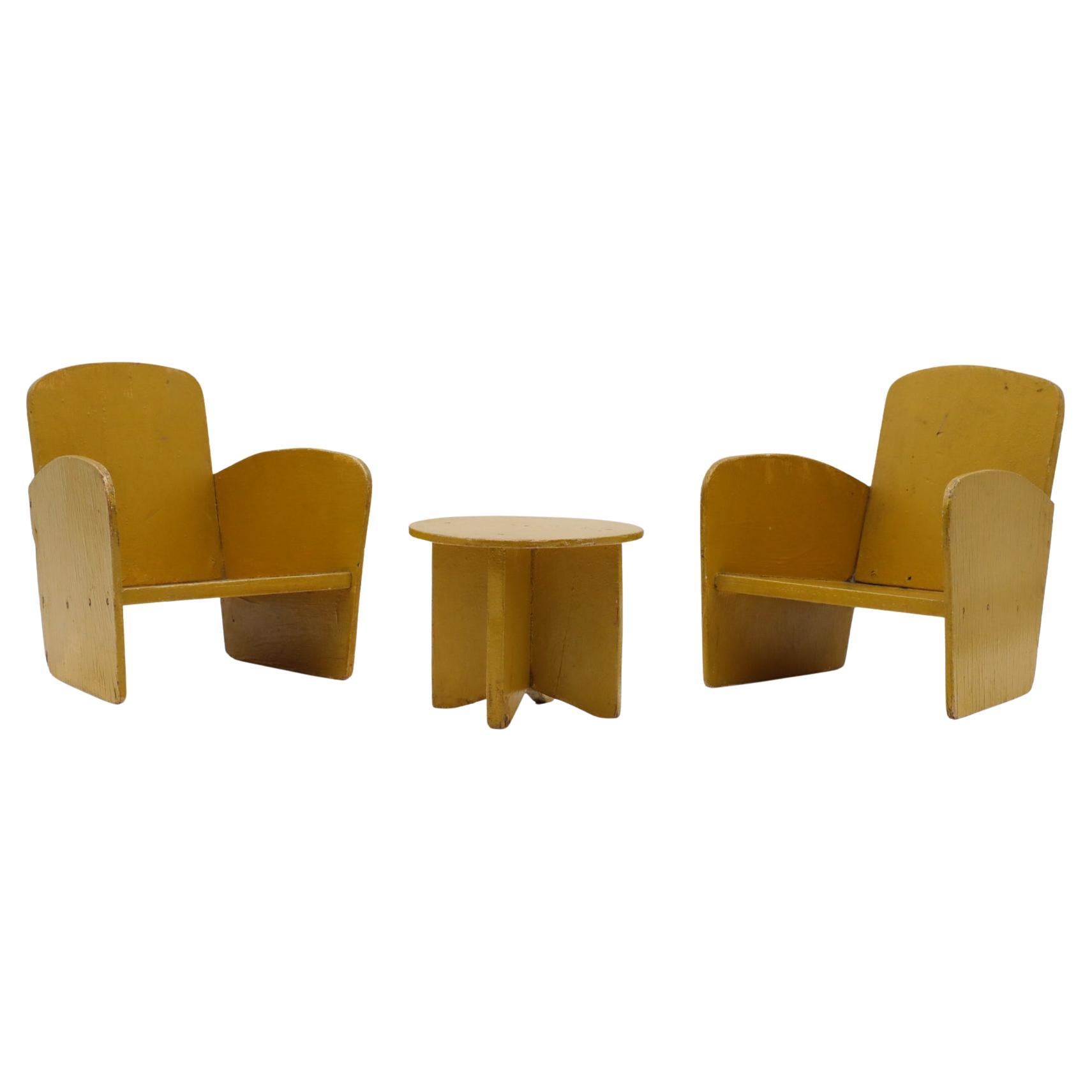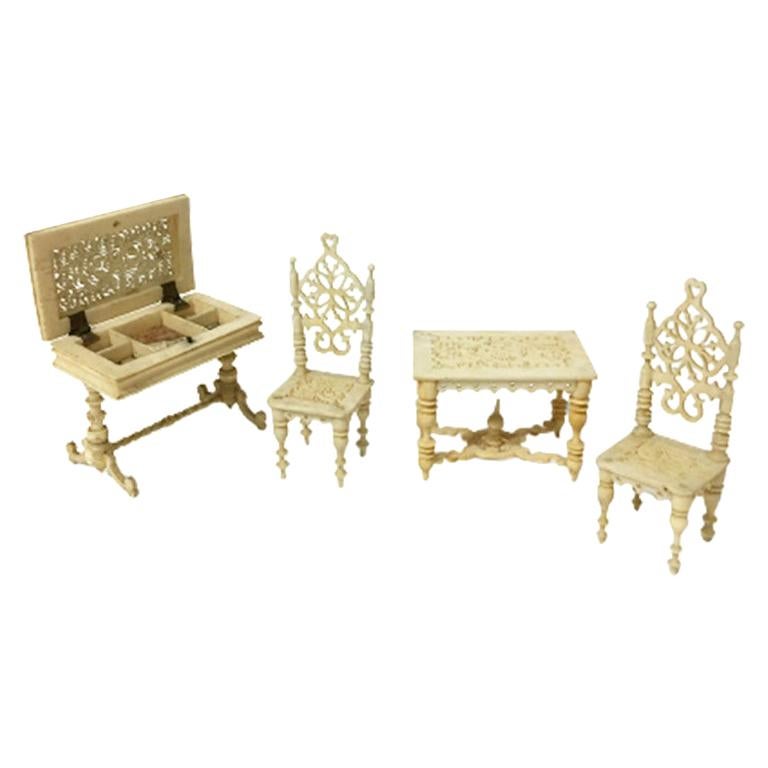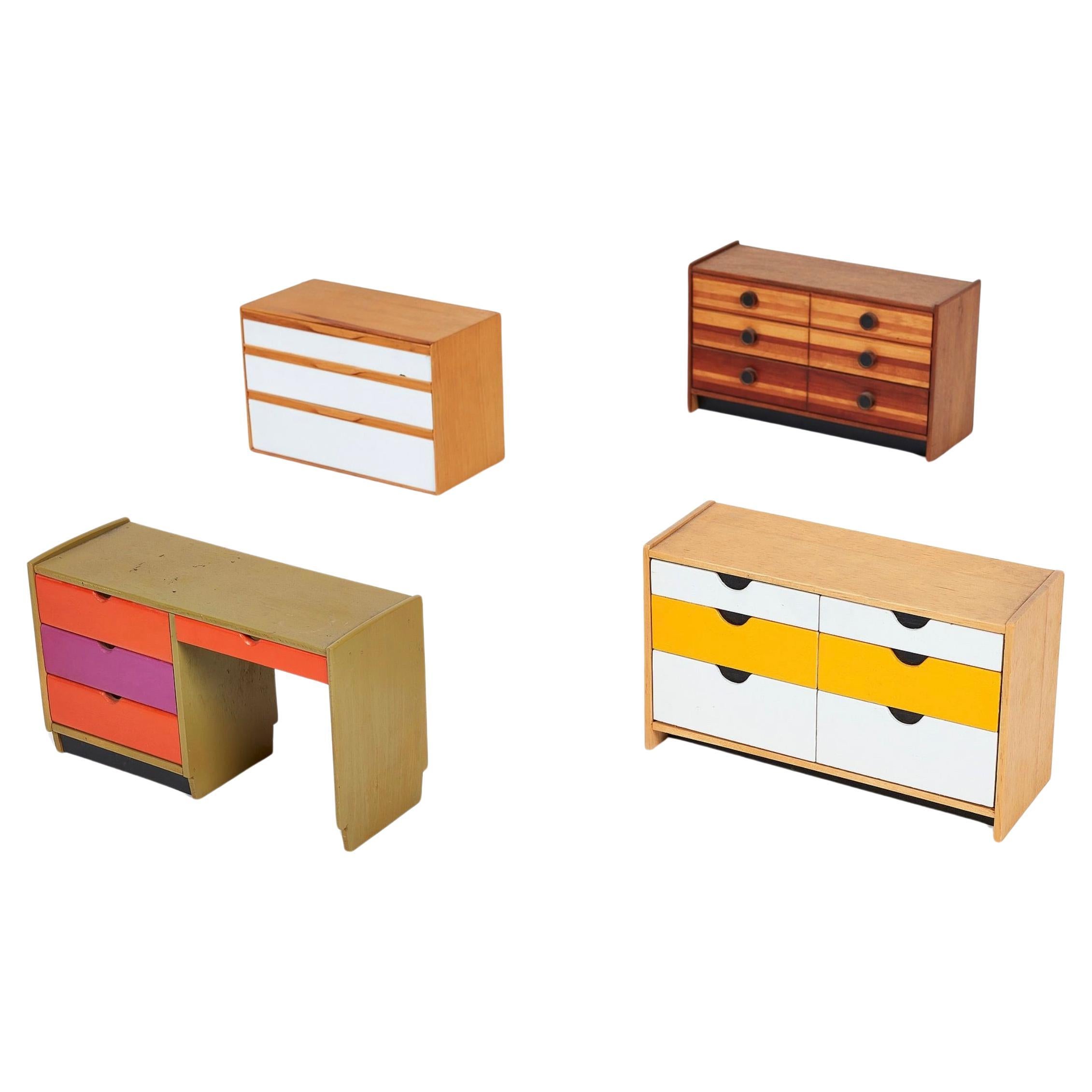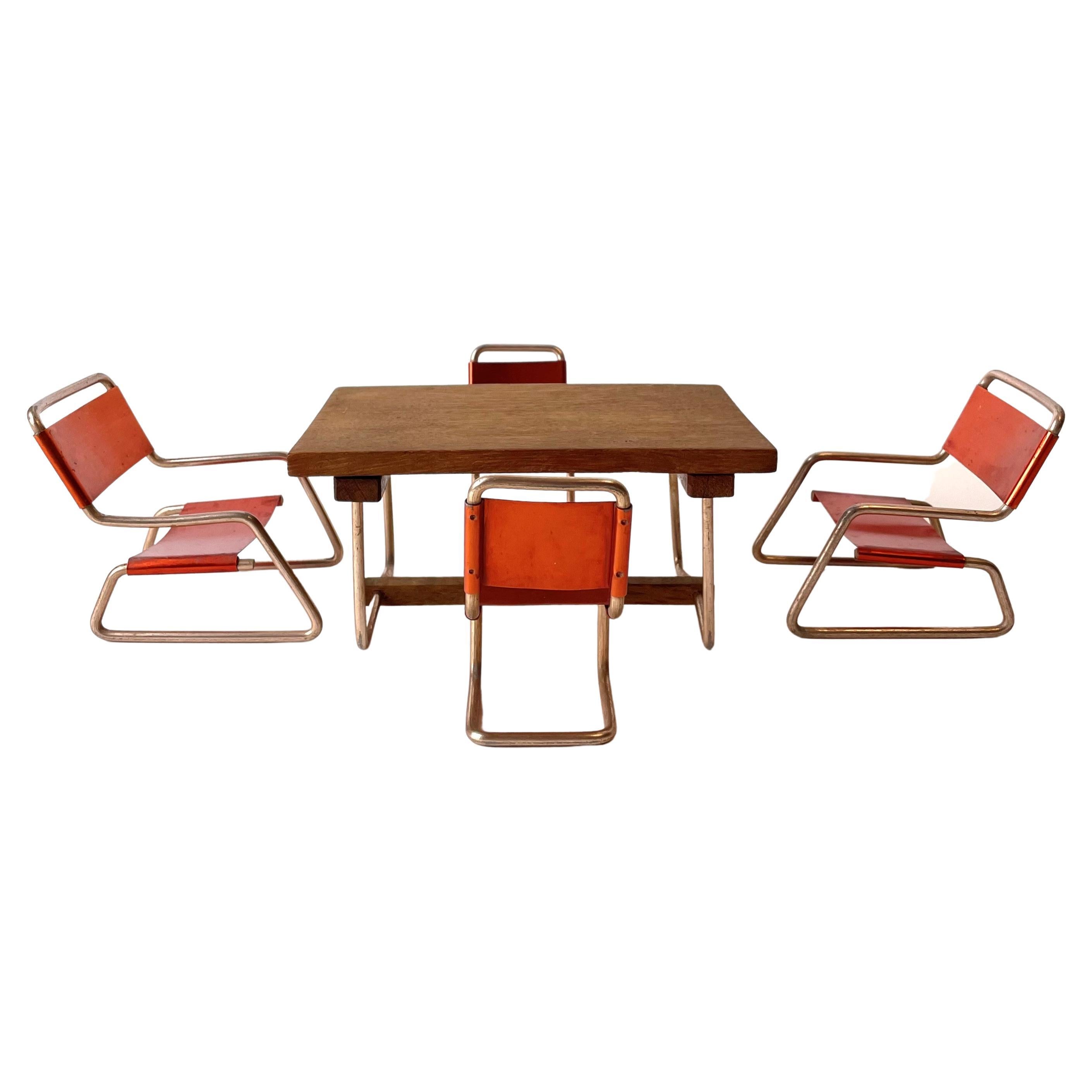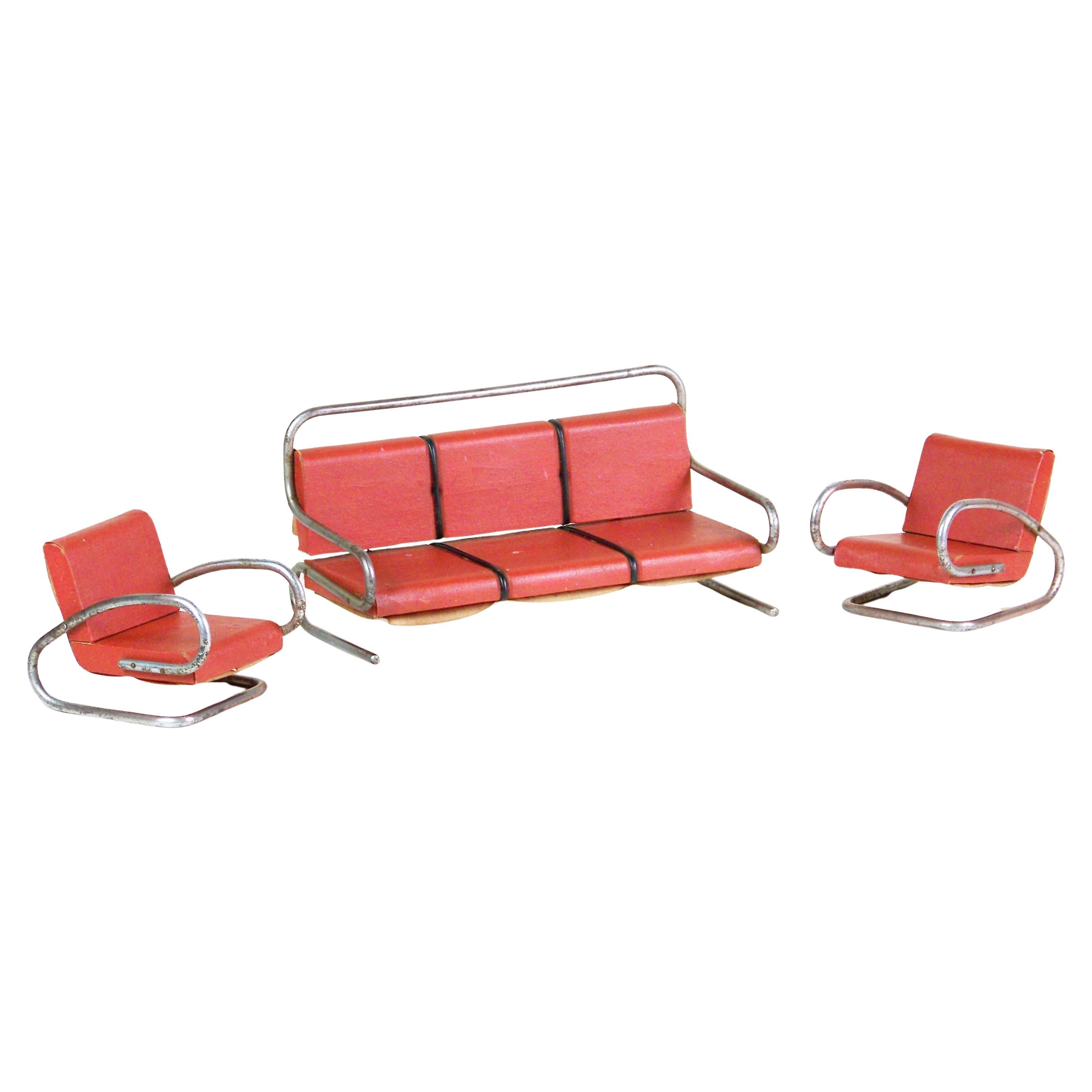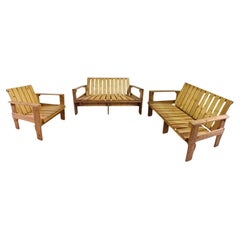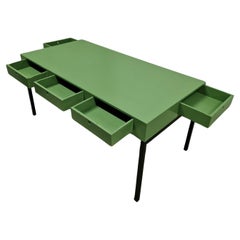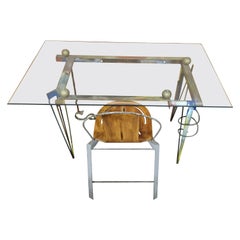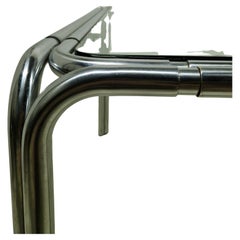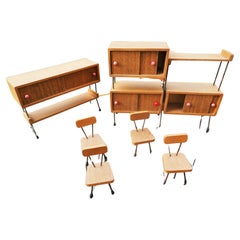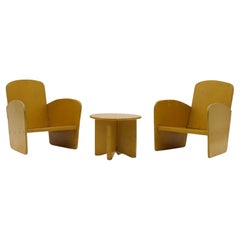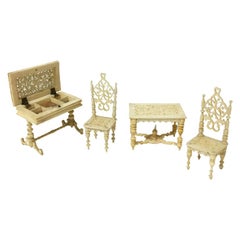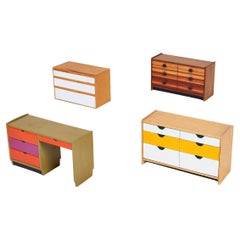Items Similar to 16 piece miniature modernist furniture set, Netherlands 1920s
Want more images or videos?
Request additional images or videos from the seller
1 of 11
16 piece miniature modernist furniture set, Netherlands 1920s
$429.45
$536.8120% Off
£317.50
£396.8720% Off
€360
€45020% Off
CA$590.70
CA$738.3720% Off
A$656.60
A$820.7520% Off
CHF 344.18
CHF 430.2220% Off
MX$8,018.66
MX$10,023.3320% Off
NOK 4,296.83
NOK 5,371.0420% Off
SEK 4,042.51
SEK 5,053.1420% Off
DKK 2,740.67
DKK 3,425.8420% Off
About the Item
Set of 16 highly original miniature furniture. It consist of a dining table with 4 chairs, 2 beds with night stands and an occasional chair an a living room set with a sofa, 2 chairs, 2 side tables and a coffee table.
Bauhaus modernist style construction.
The Staatliches Bauhaus, commonly known as the Bauhaus (German for 'building house'), was a German art school operational from 1919 to 1933 that combined crafts and the fine arts. The school became famous for its approach to design, which attempted to unify individual artistic vision with the principles of mass production and emphasis on function. Along with the doctrine of functionalism, the Bauhaus initiated the conceptual understanding of architecture and design.
The Bauhaus was founded by architect Walter Gropius in Weimar. It was grounded in the idea of creating a Gesamtkunstwerk ("comprehensive artwork") in which all the arts would eventually be brought together. The Bauhaus style later became one of the most influential currents in modern design, modernist architecture, and architectural education. The Bauhaus movement had a profound influence on subsequent developments in art, architecture, graphic design, interior design, industrial design, and typography. Staff at the Bauhaus included prominent artists such as Paul Klee, Wassily Kandinsky, Gunta Stölzl, and László Moholy-Nagy at various points.
The school existed in three German cities—Weimar, from 1919 to 1925; Dessau, from 1925 to 1932; and Berlin, from 1932 to 1933—under three different architect-directors: Walter Gropius from 1919 to 1928; Hannes Meyer from 1928 to 1930; and Ludwig Mies van der Rohe from 1930 until 1933, when the school was closed by its own leadership under pressure from the Nazi regime, having been painted as a centre of communist intellectualism. Internationally, former key figures of Bauhaus were successful in the United States and became known as the avant-garde for the International Style.
The changes of venue and leadership resulted in a constant shifting of focus, technique, instructors, and politics. For example, the pottery shop was discontinued when the school moved from Weimar to Dessau, even though it had been an important revenue source; when Mies van der Rohe took over the school in 1930, he transformed it into a private school and would not allow any supporters of Hannes Meyer to attend it.
- Similar to:Le Corbusier, Pierre Jeanneret, Charlotte Perriand Cassina (Designer)
- Dimensions:Height: 1.97 in (5 cm)Width: 6.3 in (16 cm)Depth: 2.37 in (6 cm)
- Style:Modern (Of the Period)
- Materials and Techniques:
- Place of Origin:
- Period:
- Date of Manufacture:1920-1930
- Condition:Wear consistent with age and use. Minor losses. No structural issues. Wear on the edges and some chips of paint are missing. Consistent with age and use.
- Seller Location:ECHT, NL
- Reference Number:1stDibs: LU9426237321902
About the Seller
5.0
Vetted Professional Seller
Every seller passes strict standards for authenticity and reliability
1stDibs seller since 2023
19 sales on 1stDibs
Typical response time: <1 hour
- ShippingRetrieving quote...Shipping from: ECHT, Netherlands
- Return Policy
Authenticity Guarantee
In the unlikely event there’s an issue with an item’s authenticity, contact us within 1 year for a full refund. DetailsMoney-Back Guarantee
If your item is not as described, is damaged in transit, or does not arrive, contact us within 7 days for a full refund. Details24-Hour Cancellation
You have a 24-hour grace period in which to reconsider your purchase, with no questions asked.Vetted Professional Sellers
Our world-class sellers must adhere to strict standards for service and quality, maintaining the integrity of our listings.Price-Match Guarantee
If you find that a seller listed the same item for a lower price elsewhere, we’ll match it.Trusted Global Delivery
Our best-in-class carrier network provides specialized shipping options worldwide, including custom delivery.More From This Seller
View AllModernist living room set in the manner of Gerrit Rietveld, Netherlands 1950s
By Gerrit Rietveld, Walter Gropius, Metz & Co., De Stijl
Located in ECHT, NL
Handcrafted living room or patio set. It is made in the style of Gerrit Rietveld and is clearly inspired by his legendary "kratstoel" or "crate chair" where difference lies in the amount of slats in the seat and back. This set was made during the 1950s and is entirely made from pine and assembled using round headed screws that are recessed in the wood. Made with great eye for detail.
The set consists of 2 two-seater sofas and 1 lounge chair.
Dimensions sofa:
W. 130cm
H. 70cm
D. 75cm
Dimensions chair.
W. 75cm
H. 70cm
D. 75cm
Seat height: sloping back from 33 to 27cm
Armrest height: 52cm
De Stijl (Dutch for "The Style"), also known as Neoplasticism, was a Dutch art movement founded in 1917 in Leiden. De Stijl consisted of artists and architects. In a more narrow sense, the term De Stijl is used to refer to a body of work from 1917 to 1931 founded in the Netherlands. Proponents of De Stijl advocated pure abstraction and universality by a reduction to the essentials of form and colour; they simplified visual compositions to vertical and horizontal, using only black, white and primary colors.
De Stijl is also the name of a journal that was published by the Dutch painter, designer, writer, and critic Theo van Doesburg that served to propagate the group's theories. Along with van Doesburg, the group's principal members were the painters Piet Mondrian, Vilmos Huszár, Bart van der Leck, and the architects Gerrit Rietveld, Robert van 't Hoff, and J. J. P. Oud. The artistic philosophy that formed a basis for the group's work is known as Neoplasticism—the new plastic art (or Nieuwe Beelding in Dutch).
According to Theo van Doesburg in the introduction of the magazine De Stijl 1917 no.1, the "De Stijl"-movement was a reaction to the "Modern Baroque" of the Amsterdam School movement (Dutch expressionist...
Category
Mid-20th Century Dutch De Stijl Living Room Sets
Materials
Pine
$3,282 Sale Price / set
57% Off
Modernist 5 drawer writing desk, Netherlands 1960s
By Gerrit Rietveld
Located in ECHT, NL
Minimalistic designed writing desk. The top is made from solid wood and is painted green. The top has 5 drawers. 3 located on the front and 1 on each side. The middle drawer is the d...
Category
Mid-20th Century Dutch Bauhaus Desks and Writing Tables
Materials
Wood
$1,498 Sale Price
20% Off
Post modern Memphis style artistic writing desk and chair, Germany 1980s
By Ettore Sottsass, Memphis Group, Gaetano Pesce
Located in ECHT, NL
Unique artistic writing desk and chair. The frame is made from steel and wrought iron in different shapes and sizes. Painted in several different colors. The glass top rest on 4 wood...
Category
Late 20th Century German Post-Modern Desks and Writing Tables
Materials
Metal
$2,376 Sale Price / set
53% Off
Mid century Bauhaus style dining set by t Spectrum, Netherlands 1960s
By Walter Antonis, 't Spectrum, Claire Bataille
Located in ECHT, NL
Mid century minimalist dining set. It consists of a square table with a glass top and 4 chairs.
The chairs have a steel tube frame with fabric covered backs and seats. They have the ...
Category
Mid-20th Century Dutch Bauhaus Dining Room Sets
Materials
Metal
$3,158 Sale Price / set
20% Off
Bauhaus modernist side table with multiple levels, Germany 1950s
By Bauhaus, Warren Platner, Marcel Breuer
Located in ECHT, NL
Modernist side table with multiple levels. The frame is made from tubular steel with metal rods both functional and decorative. The upper shelf is original while the bottom ones are ...
Category
Mid-20th Century German Bauhaus Tables
Materials
Metal
$953 Sale Price
20% Off
Mid century sideboard by Ditte and Adrian Heath for France & son, Denmark 1960s
By Cado, Adrian Heath, Ditte & Adrian Heath, France & Søn
Located in ECHT, NL
Mid century sideboard with sliding doors and 3 interior drawers.
Designed by Ditte and Adrian Heath and produced by France & son (CADO) in the 1960s in Denmark.
Made from solid oak...
Category
Mid-20th Century Danish Scandinavian Modern Sideboards
Materials
Oak
$3,082 Sale Price
20% Off
You May Also Like
Miniature Furniture and Chairs from the 60s
Located in Lugo, IT
Miniature furniture and chairs from the 60s
A piece of furniture is missing a rubber and a non-original red knob
Good condition.
Thanks
Category
Vintage 1960s Italian Modern Models and Miniatures
Materials
Wood
Art Deco Miniature Furniture Set Painted in Yellow
Located in Los Angeles, CA
Lovely Art Deco miniature yellow painted wood lounge chair and side table furniture set. The chairs are 5.75 x 6.25 x 6.5, table is 4.375 x 3.75 x 3.5. In lovely original condition w...
Category
Vintage 1930s Dutch Art Deco Toys
Materials
Wood
19th Century German Doll House Miniature Furniture
Located in Delft, NL
A 19th century German Doll house miniature furniture
A sewing table, a table and 2 chairs.
The sewing table has a flap and the table has 5 compartmen...
Category
Antique 19th Century German Toys and Dolls
Materials
Bone
John Kapel, Furniture Maquettes
By John Kapel
Located in Los Angeles, CA
Maquettes refer to small-scale models or prototypes often used by designers to plan or visualize larger projects before they are created on a full scale. These models serve as a way ...
Category
Vintage 1960s American Mid-Century Modern Decorative Boxes
Materials
Wood
$3,250 / set
Charming Miniature Seating Group in Bauhaus Style from the 1930s-1940s
By Bauhaus
Located in Knivsta, SE
Charming miniature seating group in aluminium and with a table top in teak. Manufactured during the 1930s-1940s in period-typical Bauhaus style.
Measure: The whole group, arranged l...
Category
Vintage 1930s European Bauhaus Models and Miniatures
Materials
Aluminum
Sofa set for dolls, functionalism, 1920s
Located in Praha, CZ
Original found condition
sofa dimensions: 25x12x12 cm
armchair dimensions: 12x10x9 cm
Category
Early 20th Century Czech Bauhaus Models and Miniatures
Materials
Chrome
$310 / set
More Ways To Browse
Netherlands Antique
Emphasis Furniture
Furniture 1920s Painted
Furniture Bauhaus Movement
Le Corbusier Hand
Antique Miniature Houses
Miniature Chairs
Brown Wassily
Modernist Bed
Antique Bed Chair
Antique 1920S Couch
1928 Couch Sofa
Arts And Craft Bed
Antique German Pottery
Mies Van Der Rohe Dining Table
Bauhaus Wassily Chair
Netherlands Bed
Paul Brown Pottery

